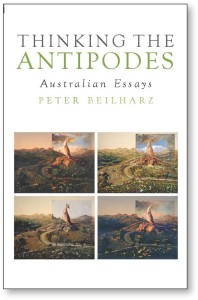Nikos Papastergiadis is Professor of Cultural Studies and Media & Communications at the University of Melbourne. His recent publications include Spatial Aesthetics: Art, Place and the Everyday (Rivers Oram Press, 2006), Metaphor + Tension: On Collaboration and its Discontents (Artspace Publications, 2004) and The Turbulence of Migration (Polity Press, 2000). He has taught at the University of Manchester and was a co-editor of Third Text. Nikos has been at the forefront of thinking about the political and creative nature of South in articles such as ‘South-South-South’ Complex Entanglements: Art, Cultural Difference & Globalization, ed. Nikos Papastergiadis (Rivers Oram Press, 2003).
What role does South play in contemporary thinking?
The idea of the South has a long history. In the recent past it has been revived as a possible frame for representing the cultural context of not just regions that are geographically located in the South, but also those that share a common post colonial heritage. In this essay I explore the affinities and tensions between the south and parallel terms such as third world, antipodes. I argue that the South can extend the existing debates on cross cultural exchange, and provide a useful perspective for representing what I call a ‘spherical consciousness’ in contemporary art.
How does the current flow of ideas around South connect with the post-colonial discourse fostered by journals like Third Text?
From the outset in 1987 the art theory and art historical journal Third Text contested the terms, questioned the structures and challenged the history of western art. The tone of writing has varied from the academic, poetic to the polemical. While the journal was founded to develop a third world perspective on contemporary art and give voice to artists who have worked in a postcolonial context, and despite the shift in editorial policy which is more sceptical of post-colonial theory,[1] the journal continues to provide an invaluable documentary function that recovers and repositions the artistic practices that was either ignored or marginalised by the dominant art historical institutions. It also plays a leading role in presenting new methods for measuring the value and meaning of art. Art history is more than capable of discovering new entrants into its own canon, but the capacity to re-think the terms of entry and the field of relations that constitutes art is not generated from within, but through an interplay with different theoretical and cultural perspectives. The postcolonial critiques of Orientalism, hybridity and the subaltern that were first developed in literary and historical accounts provided vital stepping stones in this reconfiguration of art historical methodologies. A key challenge that confronted this discourse was to develop new ways of seeing and interpreting the differences between and within cultures. For instance, the introduction of the Derridean concept of supplementarity and Homi Bhabha’s interpretation of the process of cultural translation provided new means for understanding both the tensions that arise from the interaction between different cultural practices, and the emergence of novel forms of expressions. In short, this approach not only provided more evidence of emergent practices and the historical legacies of art from the South, but it also prompted the invention of critical tools for overcoming the classification of the South as exotica, periphery and primitivism.
What do you see as the relation between the geographic South and the Global South? Is it purely coincidental?
I understand the concept of the South as a loose hemispheric term that refers to a series of places that share similar patterns of colonization, migration and cultural mixture. For me the South is also expressive of a cultural imaginary that looks outward from its own national base and against the grain of its colonial past. This appeal to a more open-ended identity is, in one critic’s eye, a betrayal of a deep imperial history.[2] In other words, any use of the language that draws from metaphoric associations with the cardinal points of cartography risks being embedded in the naturalistic discourse of magnetic polarities.
In my mind the South is a more ambivalent concept. It oscillates between a clarion call for antipodean rebelliousness and the stigmatic expression of the cultural cringe. Throughout Australia’s incomplete pursuit of republicanism the image of the Southern Cross has been a recurring symbol of resistance. It has been the trump card against the cultural imperialism of the North. Refusing to be defined by a measure that favours the North the Southern cultural chauvinist inverts this logic and declares that everything of value is already and always in the South. Peter Beiharz notes that the choices are not confined to the bad options of superior recognition according to metropolitan exclusivity or the provincial self-identification through splendid isolationism. He takes inspiration from the fact, and not just hollow boast, that distance from the North has enabled Australia to figure as the ‘world’s social laboratory of policy experiment.’ Indeed throughout the twentieth century Australia has been at the forefront of reforms and innovations in the three pillars of social welfare—wage arbitration, women’s right and multiculturalism. However, Beilharz’s narrative of the emergence of Antipodean civilizational tropes is bittersweet. While he duly notes that earlier achievements were influential in the Fabian social democratic debates, he is also painfully aware that Paul Keating’s realignment of the Labour Party with neo-liberalism paved the way for Tony Blair’s ‘third way’.[3] Keating’s own southern cultural imaginary that promised to take shape through a nascent republicanism and closer integration with Asia, was soon transformed into the target of populist scorn for the successive generations of political leaders.
In Central and Latin America a similar pattern of ambivalent identification is expressed in examples that stretch from Borges short story of the South as a frontier metaphor, Joaquim Torres Garcia’s corrective claim that the ‘North looks South’, to the analysis of cultural inferiority complexes in the writings of Octavio Paz, Gilberto Freyre and Eduardo Galeano, and more recently, the speech by Hugo Chavez in which he quoted Mario Benedetti’s poem ‘The South also Exists’.[4] Such enduring pathos for regional solidarity alongside the persistent failure to build a common cultural framework prompts a number of questions. Is the concept of the South the best frame or point from which to start, once again, as if for the first time, the endless task of collective identification? Is there any point at which the path of identity splits from the imperial past? Can such a wide spherical concept inflect the debates on planetary and cosmopolitan identity with a different historical texture and geo-political valency?[5]
How does living in Melbourne influence the way you think about the South?
I grew up in Middle Park. My strongest childhood memory is looking down the street and seeing an open horizon—the sea. My idea of the spherical consciousness starts from that view.
How can Australian universities connect with the South?
Less greed and more curiosity. Alan Davies made the call a long time ago. More than two decades ago the Australian political scientists Alan Davies suggested that ‘we should spend less time in awed upward contemplation of the great metropolitan centres and a good deal more looking sideways at the experience of like small nations, whose solutions should be better scaled to our problems, and whose definition of their problems are more likely to help us understand our own’.[6] He imagined a form of cultural exchange that would reveal insights and develop skills that would be more worthy of emulation because their fit would be closer to our own experiences. The transferability of knowledge would not be a form of adopting and applying models, but in the grasping of what Davies called the ‘nuances of likeness’.
[1] Rasheed Araeen, ‘Re–thinking History and some other things’, Third Text, Spring 2001, No 54, p 93
[2] Margaret Jolly, “The South in Southern Theory: Antipodean Reflections on the Pacific”, Australian Humanities Review, Issue 44, 2008, 79
[3] Peter Beilharz ‘Rewriting Australia’ Journal of Sociology 40, 2004
[4] Kevin Murray ‘Uruguay also Exists’ http://ideaofsouth.net/idea/idea-zero/uruguay-also-exists
[5] See Paul Gilroy After Empire London, Routledge, 2004, and Ulrich Beck ‘The Cosmopolitan Manifesto’ World Risk Society, Cambridge, Polity Press, 1999
[6] Alan Davies, ‘Small Country Blues’ Meanjin Volume 44, Number 2, 1985, p 248
 Thinking the Antipodes: Australian Essays
Thinking the Antipodes: Australian Essays